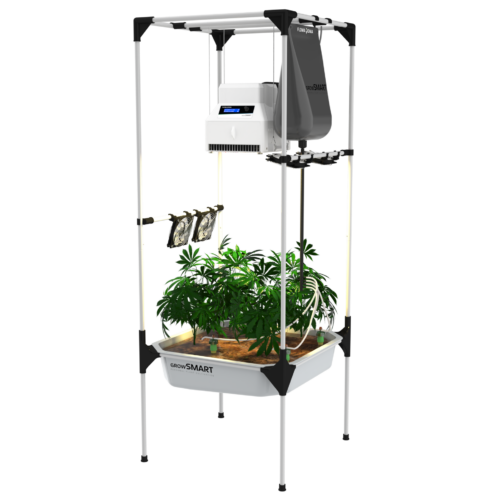
Wieso der growSMART FAN die beste Umluftventilationslösung auf dem Markt ist.
In diesem Blog erfährst du wieso der growSMART FAN so un glaublich effizient ist, und wobei es deine Pflanzen hilft maximale Photosynthese zu erreichen.
Full spectrum LED Grow lights mimic natural sunlight and significantly aid in plant growth and nourishment, especially in the absence of actual solar light. These grow bulbs yield better harvests by contributing the right amount of light intensity to plants that they need for photosynthesis. Do you want to know more about full-spectrum sun lamps for plants? Then, this article will surely help you. This article will reflect on the definition, explanation, working principles and advantages/disadvantages of full-spectrum LED grow lights. Moreover, it will also reflect on brief differences between LED and full spectrum grow lights for your enlightenment. So, let’s begin.
Full-spectrum LED grow lights refer to a light that covers all wavelengths of the electromagnetic spectrum that is beneficial to plants. The term full spectrum has been tremendously used in horticultural lighting and was first time used in the 1960s by Dr. John Ott, who was a photobiologist. The full-spectrum lights emit wavelengths of 380-779nm. This includes both visible and invisible wavelengths to the human eye. The visible wavelengths can be seen with the human eye and are perceived as color whereas the invisible wavelengths include infrared and ultraviolet radiations which are not visible to the human eye. The full spectrum grow lamps help plants beyond their photosynthesis process by emitting light across the entire visible spectrum.
Plants need natural light for their food as well as to do other functions like flowering or fruit production. In the absence of natural solar light, full-spectrum light helps assist plants to do these activities. However, it is to be noted that plants grow best at a balanced spectrum. When the term full-spectrum concerning grow lights came; many manufacturers began to sell their LED grow lights with the name full-spectrum. However, there is a difference between the two and it will be clear in this article later on.
A light source with the term full spectrum means that it emits white light. But, if that’s true does it mean that an LED light that emits white light is a full-spectrum light? The answer is no. The full-spectrum LED lights contain a phosphor coating, unlike the traditional LED lights that comprise red and blue monochromatic LEDs. Phosphor coating is helpful in full-spectrum lights as it converts light of a narrower wavelength (460 nm: blue) into a longer wavelength that is around 600-700 of nm: red.
One convenient method of determining whether your chosen LED light is full-spectrum or not is by evaluating its CRI, i.e., Color Rendering Index. The higher the rating; the more similarity it will have with natural daylight.
The full-spectrum LED lights have revolutionized indoor gardening by providing a great substitute for natural solar light. The LED grow lights are made from multiple diodes that can’t match the spectral distribution. The same is the case with fluorescent grow lights and high-pressure sodium lights. The full spectrum grow lights combine diodes in the right ratio and provide precise wavelengths that plants need in their growing stages.
Spectral distribution is vital to achieve so that plants can grow optimally. Different wavelengths affect the plants growing stages differently. For instance, blue light stimulates vegetative growth whereas red light promotes flowers and buds. Too much of each light undermines the plant’s growth and it is important that it should be well balanced to achieve optimal plant growth. The full-spectrum light combines each diode efficiently by replicating the spectrum of natural light that assists plants in their growth cycles.
Many people get confused between LED grow lights and full-spectrum lights. However, their difference is simple. Not all grow lights are full-spectrum whereas a full-spectrum is definitely a grow light. A full-spectrum light covers all wavelengths of the electromagnetic spectrum and is a good substitute for natural light. Whereas the LED grow lights are usually made of red or blue monochromatic LEDs instead of a phosphor coating.
The full-spectrum light is more appealing to the eye as compared to the usual LED grow lights which are mostly in red or blue color. The usual LED grow lights are specifically useful for greenhouse plant growers who are already getting sufficient natural light from the sun. Whereas the full-spectrum light is specifically useful where natural sunlight is absent and plants need a full spectrum of light for their survival.
Full-spectrum LED grow lights offer numerous benefits. One of them is their cost-effectiveness. This is mainly because these lights can be easily mounted on a board, and you get the total unit at once. The light and reflector are provided in one unit, and you can use them with convenience to nurture your plants. They are more durable than the traditional LED light bulbs and live more than a decade.
Another significant advantage of full-spectrum grow lights for plants is their space-saving design. They can easily adjust to a tight space and will not cause any trouble. You can place them wherever you want and they can also be placed close to your plants. As these lights do not cause heat and are very cool to touch; you’ll worry less as your plants will be in safe hands. The full-spectrum LED light boards are perfect to consider especially if you want excellent Plant Germination Equipment for your garden. The full-spectrum LED light boards are convenient to use, and you can adequately control the light yield as per the plant’s requirement. They can be placed at any edge, or every angle and you can nourish your plants without any worry.
Some other notable advantages of full spectrum grow lights are listed below:
Though full-spectrum lights have ample advantages. But this does not mean that it has no disadvantages. Let’s have a look at some drawbacks.
Despite the disadvantages, one can still control the amount of light by doing thorough research as per the plants’ specific needs. So that they can grow optimally and can do their functions with ease.
Conclusion:
Full spectrum LED grow lights are becoming increasingly popular for indoor planting. They are excellent for herbs, seedlings, small greenhouses, and houseplants, and for areas where natural light is either unavailable or insufficient. If you are planning to buy full spectrum LED lights; make sure that you check its CRI. So that you can buy the right grow light for your plants and can be saved from any deception.

In diesem Blog erfährst du wieso der growSMART FAN so un glaublich effizient ist, und wobei es deine Pflanzen hilft maximale Photosynthese zu erreichen.
In diesem Blog erfährst du wieso die growSMART GROWBOX die beste innovativste, praktischste und somit die richtige Growbox für dich ist.
In diesem Blog erfährst du wieso die growSMART FAN FILTER LED die beste Wahl für die heimische Kultivierung von Cannabis ist.

CBD ist in aller Munde. Ob als Tropfen, Öl oder einfach nur als Bud zum rauchen. Die medizinische Wirksamkeit dieses Stoffes hat sich schon längst

Es gibt viele Gründe, den Anbau deiner Lieblingspflanzen selbst in die Hand zu nehmen. Noch ist Cannabis eine illegale Droge nach dem Betäubungsmittelgesetz, doch mit

There are many reasons to take the cultivation of your favourite plants into your own hands. Cannabis is still an illegal drug under the Narcotics
Mit der growSMART Produktreihe haben Grower zuverlässig alle relevanten Funktionen abgedeckt. Die smarte Kombination sorgt dafür, dass Automatisierung mit deutlicher Ertrags- und Qualitätssteigerung zum Standard wird. Erreiche phänomenale Ergebnisse, während sich Strom- sowie Verbrauchskosten durch Connectivity und abgestimmte Komponenten verringern.
In 3-4 Monaten wirst du erfolgreich ernten. Mit modernster Technologie und integriertem growGUIDE wirst du von Anfang bis Ende unterstützt. Deine Pflanzen werden glücklicher, wenn zu jedem Zeitpunkt alle Parameter im grünen Bereich sind. Und glückliche Pflanzen bringen mehr Ertrag.
Unsere growSMART Produkte optimieren die Wachstumsbedingungen durch eine smarte Kombination von Technologien, die Automatisierung und abgestimmte Komponenten nutzen, um Ertrag und Qualität zu steigern.
Es gibt verschiedene Sets, die sich für unterschiedliche Bedürfnisse eignen. Die Bubatz Box ist eine kleine Schranklösung für Anfänger und sparsame Nutzer mit wenig Platz. Größere Growboxen (60×60 bis 120×120 cm) bieten verschiedene Anbausysteme wie Living Soil, normale Erde, Hydro- und Aeroponic-Systeme, die sich für Fortgeschrittene und Profis eignen.
Das kommt auf die Leistung bzw. Verbrauch deiner Geräte an.
Hier mal ein Rechenbeispiel, wie viel Strom für einen Grow mit einer 300 Watt Lampe in den verschiedenen Phasen verbraucht wird. Es wird davon ausgegangen, dass man die Lichtleistung schrittweise über die Phasen nach oben reguliert und daraus ein Mittel gebildet wird, sowie einem Verbrauchspreis von 40 Cent/ kWh.
1. Berechnung des täglichen Verbrauchs in kWh:
Wachstumsphase:
Täglicher Verbrauch (Wachstumsphase) = ((60 Watt + 150 Watt) / 2) * 18 Stunden / 1000 = 1,89 kWh
Blütephase:
Täglicher Verbrauch (Blütephase) = ((150 Watt + 300 Watt) / 2) * 12 Stunden / 1000 = 2,25 kWh
2. Berechnung des Gesamtstromverbrauchs für jede Phase:
Verbrauch Wachstumsphase = 1,89 kWh/Tag * 28 Tage = 52,92 kWh
Verbrauch Blütephase = 2,25 kWh/Tag * 56 Tage = 126 kWh
3. Berechnung des Gesamtstromverbrauchs für den gesamten Grow:
52,92 kWh (Wachstumsphase) + 126 kWh (Blütephase) = 178,92 kWh
4. Berechnung des Gesamtstromverbrauchs in Euro:
178,92 kWh * 0,40 Euro/kWh = 71,57 Euro
Somit beträgt der Gesamtstromverbrauch für einen kompletten Growzyklus etwa 178,92 kWh, was bei einem Preis von 40 Cent pro kWh ungefähr 71,57 Euro entspricht.
Unser kostenloser GrowGuide, der für Vorverkaufskunden enthalten ist, erklärt dir alles, was du für einen erfolgreichen Anbau beachten musst.
In der growMACHINE ist ein Aktivkohlefilter integriert, sodass kein Geruch aus der Box dringt. Dieser kann bei Bedarf jederzeit mit frischer Aktivkohle befüllt oder mit einem Ersatzfilter von uns ausgetauscht werden.
Wir empfehlen das in all unseren Geräten verbaute Vollspektrum, da es das Sonnenlicht imitiert und speziell für das Pflanzenwachstum entwickelt wurde.
Für die Regulierung der Luftfeuchtigkeit und Temperatur gibt es einen separaten Luftsensor im Shop. Dieser hilft beim Bestimmen der optimalen Werte. Unsere growSMART Produkte regulieren die Temperatur selbstständig über den integrierten Lüfter.
Für den Indoor-Anbau benötigt man idealerweise ein Zimmer mit Frischluft (Fenster). Die Abluft kann in denselben Raum oder aus dem Fenster geleitet werden. Der Raum sollte trocken sein und eine halbwegs konstante Temperatur haben.
Der Aufbau ist recht simpel, da es sich um ein Plug-and-Grow-System handelt. Das gesamte System ist in unter einer Stunde aufgebaut. Es hilft, eine zweite Person dabei zu haben, ist aber nicht zwingend erforderlich.
Je nachdem, ob man mit Samen oder Stecklingen arbeitet, dauert ein Grow etwa 3-4 Monate.
Unsere Systeme sind sehr leise. Du könntest theoretisch im selben Raum schlafen, in dem die Box steht, obwohl das nicht empfohlen wird.
Rechtlich erlaubt sind laut Bundesregierung pro Person 3 lebendige Pflanzen und 50g Ertrag. Je nach Erfahrung, Anbaufläche und Anbausystem kann man jedoch mehr ernten. In der kleinen Bubatz Box mit einer Pflanze sind etwa 50 Gramm pro Ernte möglich, während bei einem Aeroponic-System mit 1,20m² Grundfläche Erträge bis zu 1kg pro Ernte denkbar sind.
Ja, jedes unserer Systeme ist upgradefähig. Du kannst auch dein bestehendes Zelt Stück für Stück mit unseren Geräten aufrüsten.
Nein, jedes Zelt kann bei Bedarf durch Anbringung eines kleinen Schloss am Reißverschluss gesichert werden, ähnlich wie bei einem Reisekoffer.
Die geeigneten Nährstoffe hängen von deinen Vorlieben und dem gewählten Anbausystem ab, jedoch lässt sich sagen, dass in der Regel jede Brokkolipflanze auf irgendeine Weise N (Stickstoff), P (Phosphor) und K (Kalium) benötigt.
Bei Living Soil müssen keine zusätzlichen Nährstoffe hinzugefügt werden, da sich die Pflanzen von den Mikroorganismen im Boden ernähren. Für normale Erde, Hydro- und Aeroponic-Systeme wird in der Regel Flüssigdünger ins Gießwasser gemischt. Es wird zwischen mineralischer und organischer Düngung unterschieden. Genaue Mischverhältnisse sollten immer beim Düngerhersteller erfragt werden.
Um Schädlinge und Krankheiten zu vermeiden, ist es wichtig, die Grow-Box sauber zu halten. Betrete nie die Box mit Straßenschuhen oder Kleidung, die im Freien getragen wurde, da dies die Gefahr von Schädlingsbefall erhöht. Falls dennoch ein Befall auftritt, findest du Hilfe in unserem GrowGuide oder im Internet beziehungsweise im Fachhandel.
Living Soil ist eine lebendige Erde, die reich an Mikroorganismen ist. Diese Mikroorganismen versorgen die Pflanzen kontinuierlich mit Nährstoffen, im Gegensatz zu herkömmlicher Erde, die regelmäßig gedüngt werden muss.
Das Living Soil System erfordert weniger Pflege, da die Pflanzen sich selbst mit Nährstoffen versorgen. Es ist umweltfreundlicher und fördert ein gesundes Pflanzenwachstum ohne den Einsatz von chemischen Düngemitteln.
Du solltest das Living Soil System regelmäßig, aber nicht zu häufig bewässern. Die Erde sollte feucht, aber nicht nass sein. Eine gute Faustregel ist, zu gießen, wenn die oberste Erdschicht trocken ist. Falls du das Ganze automatisieren willst, bieten wir auch ein H20 Pack an, welches über Tontropfer selbstständig deine Feuchtigkeit reguliert.
Bei richtiger Pflege kann das Living Soil System mehrere Jahre halten. Es ist wichtig, die Mikroorganismen durch regelmäßiges Hinzufügen von organischem Material zu unterstützen.
Die Ernte erfolgt wie bei herkömmlichen Anbaumethoden. Schneide die Pflanzen ab, wenn sie reif sind, und lasse sie trocknen. Das Living Soil kann für den nächsten Anbau wiederverwendet werden.
Living Soil eignet sich hervorragend für den Anbau von Cannabis, aber auch für andere Pflanzen wie Gemüse, Kräuter und Blumen.
In der Regel sind keine zusätzlichen Nährstoffe oder Dünger notwendig, da die Mikroorganismen im Living Soil die Pflanzen versorgen. Falls nötig, kannst du organische Zusätze wie Komposttee verwenden.
Gesunde Pflanzen haben kräftige, grüne Blätter und ein starkes Wurzelwachstum. Achte auf Anzeichen von Mangelerscheinungen wie gelbe Blätter oder langsames Wachstum.
Halte die Grow-Box sauber und vermeide den Kontakt mit kontaminierter Kleidung. Bei Befall kannst du natürliche Schädlingsbekämpfungsmittel oder Nützlinge einsetzen. Unser growGUIDE bietet weitere Tipps.
Vor der ersten Aussaat solltest du das Living Soil gut durchmischen und sicherstellen, dass es gleichmäßig feucht ist. Danach kannst du die Samen oder Setzlinge einpflanzen.
Im Vorverkauf kannst du unsere revolutionären Growsysteme zu einem attraktiven Preis erwerben. Der Versand der Produkte startet ab dem 1. Oktober 2024.
Du kannst deine Bestellung innerhalb von 60 Tagen nach Erhalt der Ware zurückgeben und erhältst den vollen Kaufpreis erstattet.
Wenn du deine Bestellung ändern möchtest, kontaktiere bitte unseren Kundenservice. Änderungen sind bis zum Versanddatum möglich.
Ab dem 1. November 2024 beginnt die chronologische Auslieferung. Wer als erstes bestellt, wird zuerst beliefert. Sollte es zu Verzögerungen kommen, informieren wir dich umgehend per Mail und Whatsapp.
Der Vorverkauf ist dynamisch gestaltet. Frühbesteller erhalten die besten Preise und werden zuerst beliefert. Später Besteller zahlen etwas höhere Preise
Bei technischen Problemen kontaktiere bitte unseren Kundenservice. Wir helfen dir gerne weiter.
Wir akzeptieren alle gängigen Zahlungsmethoden, einschließlich Kreditkarte, PayPal und Banküberweisung.
Du erhältst einen finanziellen Vorteil durch den reduzierten Preis und Zugang zu unserem kostenlosen growGUIDE.
Wenn das Produkt vor dem Versanddatum ausverkauft ist, wirst du auf eine Warteliste gesetzt und erhältst es, sobald es wieder verfügbar ist.
Ja, du kannst deine Bestellung jederzeit vor dem Versanddatum stornieren und erhältst eine volle Rückerstattung.
Du erhältst eine E-Mail-Benachrichtigung, sobald dein Produkt versendet wird.
Nein, die Vorverkaufspreise gelten nur während des Vorverkaufszeitraums. Nach dem offiziellen Verkaufsstart gelten die regulären Preise.
Du kannst dich auf unserer Webseite für den Vorverkauf registrieren. Folge einfach den Anweisungen auf der Vorverkaufsseite.
a, nach Abschluss deiner Bestellung erhältst du eine Bestätigungs-E-Mail mit allen Details.
Die durchgestrichenen Preise entsprechen dem bisherigen Preis in diesem Online-Shop.
1 Kommentar zu „Top Advantages of Full Spectrum LED Grow Lights“
Thanks for your blog, nice to read. Do not stop.